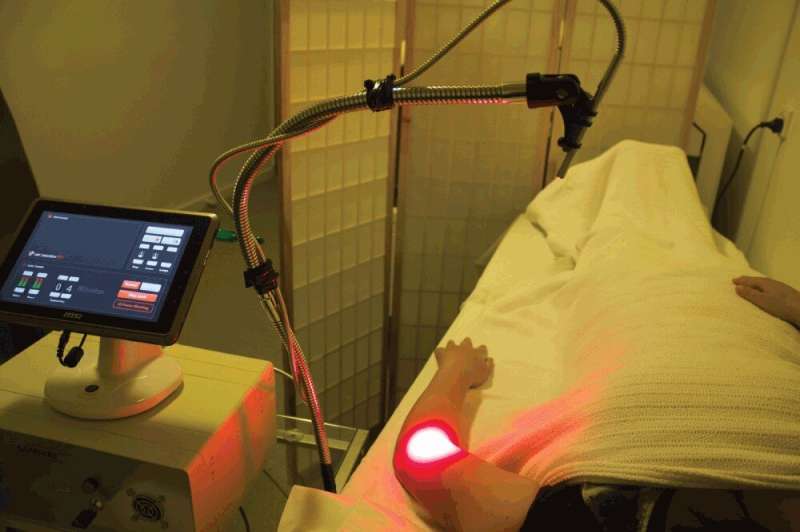This article has been reviewed according to Science X's editorial process and policies. Editors have highlighted the following attributes while ensuring the content's credibility:
fact-checked
trusted source
proofread
Drug with a light switch: Researcher investigates chemotherapy without side effects

Nausea, neurologic pain and hair loss are some of the severe side effects of chemotherapy. But they are not a necessary hardship, says biochemist Liyan Zhang. Together with Leiden biologists and others, she achieved promising results with a drug that is only active in combination with light. Zhang will defend her Ph.D. on 4 July.
Chemotherapy is both effective and dreaded at the same time. The patient is injected drugs consisting of toxic molecules, some of which often contain a metal, for example platinum. Using molecules that are toxic to the tumor cells is great, but it is not great to also kill healthy cells in the patient. "The drug is also active in healthy tissues and that often causes serious side effects," says Zhang who did her Ph.D. research at the Leiden Institute of Chemistry (LIC).
Zhang and her supervisor, chemistry professor Sylvestre Bonnet, developed a chemotherapy that only works when you shine visible light on it. The molecule contains a metal component based on ruthenium that gives the molecule light-switching properties. If proven to work safely, this family of molecules could replace current chemotherapies by safer alternatives.
Zhang says, "You administer the drug, and then you wait for the drug to reach the tumor. Then you shine light on the tumor using a laser. Of course it is easier at the surface of the body. The skin, the lungs, or the bladder are easily accessible to light irradiation. However, with optical fiber technology we can also bring the light deeper into the body, for example in the brain or liver."
Safe in the dark, toxic by light
Zhang showed that when green light is applied to the tumor, the drug becomes highly toxic to cancer cells in petri dishes, but also in mice and zebrafish models of real tumors. "I felt great when I saw the trace of the drug in the cancer cells or in a transparent zebrafish by microscope, when I could see that something that we expected was happening. We showed that our drugs were very safe in the dark at certain doses, while activation with light made the drug active. Very importantly, the active part of the drug can efficiently accumulate in the tumor area, even if it must cross the blood-brain barrier to reach a brain tumor."
The research in mice took place with the help of colleagues in China. For the research in zebrafish embryos, Zhang only needed to step a few meters to her colleagues from the Faculty of Science of Leiden University. "I told my fellow Ph.D. student Gangyin Zhao who works at the Institute of Biology Leiden that I wanted to test my drug in an animal model. He works with zebrafish embryo tumor models and he was happy to help. We and our promoters had a very pleasant collaboration and interesting conversations about that project."
When will people benefit from this drug?
Supervisor Sylvestre Bonnet is of course very pleased with the results his Ph.D. student managed to achieve. What remains to be done before the new drug can cure people of cancer? Bonnet says, "The first step is probably to obtain activation with red light. Green light is currently being tested clinically for bladder cancer in Canada, but it is does not penetrate very deep in biological tissues. Mice and zebrafish tumor models are small so their tumors are small as well, but in humans it is another dimension. Ideally we would need red or near-infrared light activation of this kind of drugs. There is also a range of experiments to be performed to demonstrate safety of the pro-drug for the brain."



















